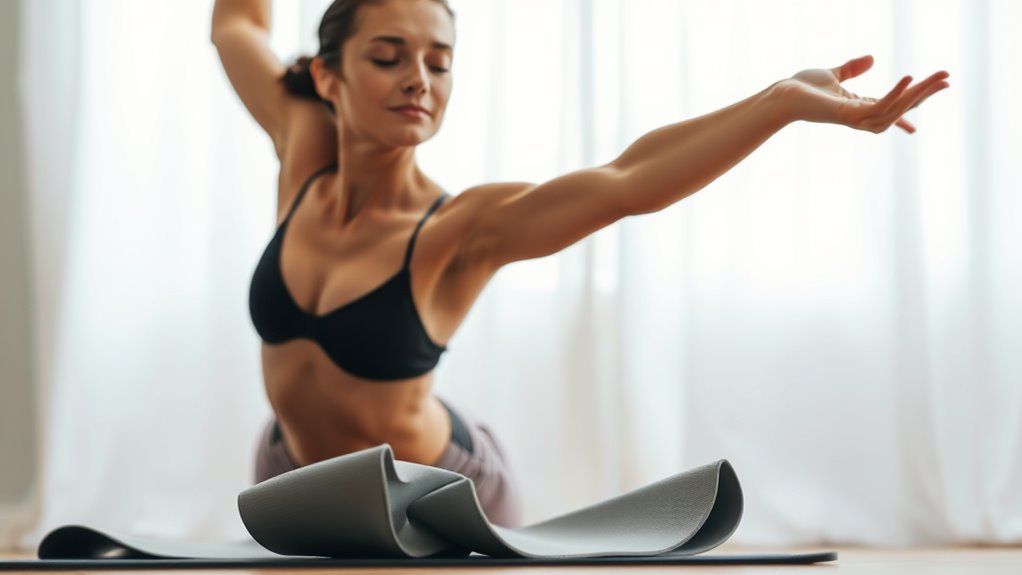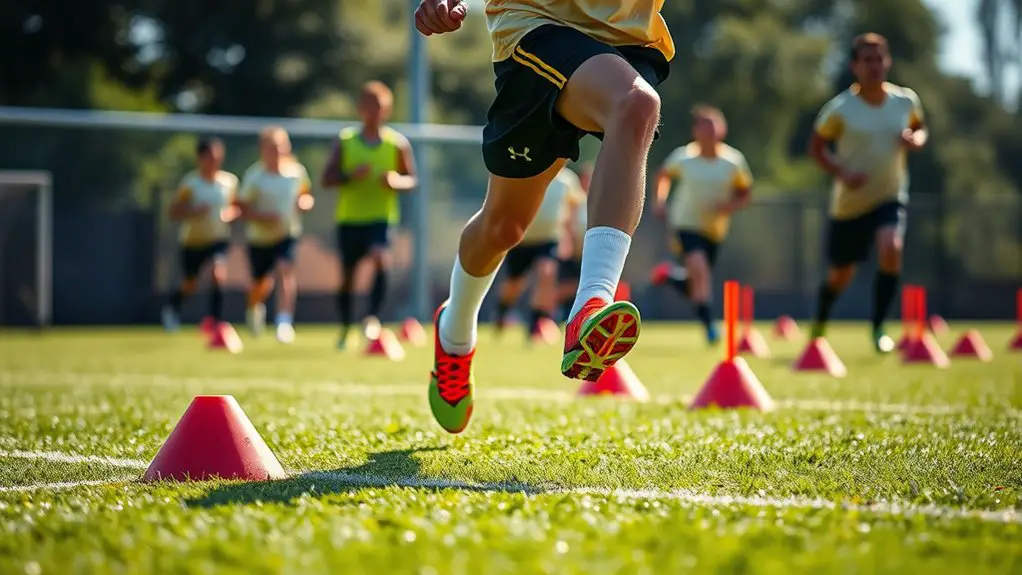Improving your flexibility is essential for achieving a better follow-through in sports. Focus on key muscle groups like hip flexors and shoulders, using dynamic stretching to warm up and static stretching to enhance range of motion. Incorporate yoga into your routine for added benefits. Strength training also plays a role by balancing strength with flexibility. Stay consistent and track your progress. You'll discover more effective tips and techniques to enhance your flexibility and performance.
Understanding the Importance of Flexibility in Sports
When you consider the demands of various sports, it's clear that flexibility plays an important role in performance and injury prevention. You want to release your full potential, and enhancing your flexibility can deliver just that. Think about how flexibility benefits you by allowing for smoother movements and better range of motion. Whether you're sprinting, jumping, or swinging, being more flexible helps you execute those actions with greater ease and efficiency.
Improving your flexibility not only boosts your sports performance but also helps reduce the risk of strains and sprains. You can move freely, react quickly, and maintain control in high-pressure moments. Plus, a well-stretched body recovers faster, keeping you in the game longer. Incorporating mobility training as a crucial part of your routine can significantly enhance your flexibility. So, embrace flexibility training as a crucial part of your routine. It's your pathway to freedom in sports and an indispensable tool for achieving your athletic goals.
Key Muscle Groups to Focus On
To enhance your flexibility and improve follow-through, focusing on key muscle groups is essential. You should pay special attention to your hip flexors, shoulder mobility, and core stability. Strengthening and stretching these areas can make a significant difference in your overall performance. Additionally, prioritizing mobility training can enhance performance by improving your range of motion and movement efficiency.
Hip Flexors Importance
Hip flexors play an essential role in your overall flexibility and athletic performance. These muscles connect your spine to your legs, making them vital for movements like running, jumping, and even walking. When you improve your hip mobility, you enhance your range of motion and reduce the risk of injury. Incorporating hip flexor stretches and hip mobility drills into your routine can release your body's potential and give you that freedom you crave.
| Exercise Type | Benefits | Frequency |
|---|---|---|
| Hip Flexor Stretches | Increases flexibility | 3-4 times a week |
| Hip Mobility Drills | Enhances range of motion | Daily |
| Dynamic Warm-Ups | Prepares muscles for activity | Before workouts |
| Static Stretches | Aids recovery | After workouts |
| Strengthening Moves | Builds muscle support | 2-3 times a week |
Shoulder Mobility Exercises
Shoulder mobility is essential for maintaining overall flexibility and preventing injuries, especially for athletes and active individuals. To achieve that freedom of movement, you need to focus on shoulder stretches and mobility drills. Start with arm circles to warm up your joints, then progress to doorway stretches that open up the chest and shoulders. Try the cross-body shoulder stretch to target the deltoids and a rotator cuff stretch for added stability. Incorporating these exercises into your routine will enhance your range of motion and improve your follow-through. Remember, consistency is key! So, don't rush it—take your time, listen to your body, and enjoy the process of becoming more mobile and free in your movements.
Core Stability Training
Core stability is essential for enhancing athletic performance and preventing injuries, and focusing on key muscle groups can make all the difference. When you prioritize your core, you're not just working on your abs; you're engaging your pelvis, lower back, and hips. These areas play a vital role in maintaining balance and control during movement. Incorporating balance training into your routine will help you develop a strong foundation, allowing for smoother shifts and more powerful follow-throughs. Exercises like planks, bridges, and stability ball workouts can strengthen these muscle groups effectively. Remember, a stable core allows you the freedom to move dynamically while minimizing the risk of injury, so embrace the journey to better core stability and release your potential.
Dynamic Stretching Techniques
Although many people focus on static stretching as part of their warm-up routine, incorporating dynamic stretching techniques can greatly enhance your flexibility and overall performance. Dynamic warm-ups get your muscles and joints moving, increasing blood flow and preparing your body for action. Think of mobility drills like leg swings or arm circles—these exercises not only improve your range of motion but also help prevent injuries.
Start with gentle movements that mimic your sport or activity. For instance, if you're a runner, include high knees or butt kicks to loosen up your legs. The key is to keep moving; static holds won't serve you here. As you progress, increase the intensity and range of your movements. Integrating these dynamic stretching techniques into your routine will make you feel more agile and free, allowing for a smoother follow-through in any physical endeavor. Embrace the movement, and your body will thank you! Additionally, dynamic stretching activates muscles and prepares your body for action, enhancing your overall readiness.
Static Stretching for Improved Range of Motion
While dynamic stretching is great for warming up, static stretching plays an essential role in improving your range of motion. Incorporating static stretch techniques into your routine can release new levels of freedom in your movements. By holding stretches for longer periods, you'll not only enhance flexibility but also enjoy numerous benefits of stretching, including:
- Increased blood flow to muscles, promoting recovery
- Relief from muscle tension, allowing for smoother movements
- Enhanced posture, leading to improved overall performance
When you commit to static stretching, you're investing in your body's ability to move freely and effortlessly. It's not just about flexibility; it's about feeling unrestricted in every movement you make. Embrace these techniques, and watch as your follow-through improves, giving you the confidence to express your full physical potential. Remember, a few minutes of static stretching can lead to a lifetime of benefits, releasing the freedom you desire. Additionally, staying hydrated is crucial, as proper hydration helps support muscle function and flexibility during your stretching routine.
Incorporating Yoga Into Your Routine
If you're looking to enhance your flexibility, incorporating yoga into your routine can be a game changer. You'll not only experience numerous benefits, like improved balance and reduced stress, but also learn simple poses that fit seamlessly into your day. Let's explore how these practices can elevate your flexibility and overall well-being. Additionally, focusing on muscle recovery through specific yoga poses can significantly improve your flexibility over time.
Benefits of Yoga
Incorporating yoga into your routine can markedly enhance your flexibility and overall well-being. By embracing this practice, you'll not only stretch your body but also reveal a treasure trove of yoga benefits, including:
- Greater mental clarity, allowing you to focus on what truly matters
- Enhanced emotional balance, freeing you from stress and anxiety
- Increased physical freedom, empowering your movements in everyday life
With regular yoga practice, you can cultivate a sense of peace and liberation. You'll discover that each pose invites you to connect deeper with yourself, letting go of limitations and embracing your true potential. The journey toward flexibility is not just about the body; it's about freeing your mind and spirit, leading to a more fulfilling life.
Simple Yoga Poses
To ease into a yoga routine, you don't need to start with advanced poses; simple stretches can be just as effective. Incorporating beginner poses into your daily practice can help enhance flexibility and promote overall wellbeing. Here are a few poses to get you started:
| Pose | Yoga Benefits | Duration |
|---|---|---|
| Cat-Cow | Increases spinal flexibility | 1-2 minutes |
| Downward Dog | Stretches hamstrings, calves | 1-2 minutes |
| Child's Pose | Relieves tension, calms mind | 2-3 minutes |
| Forward Bend | Lengthens spine, improves posture | 1-2 minutes |
Foam Rolling for Muscle Recovery
While you've probably heard about the benefits of foam rolling, understanding its role in muscle recovery can truly enhance your post-workout routine. Integrating foam rolling into your recovery techniques can help you feel more liberated and ready to tackle your next session.
Consider these foam rolling benefits:
- Increased blood flow: It helps deliver oxygen and nutrients to tired muscles.
- Reduced muscle soreness: You'll bounce back faster, allowing you to train harder.
- Improved flexibility: Your muscles will feel looser, enhancing your overall performance. Additionally, foam rolling performs self-myofascial release, breaking up knots that can limit movement.
The Role of Strength Training in Flexibility
When it comes to flexibility, strength training plays a vital role in finding the right balance. You'll discover how muscle activation techniques can enhance your range of motion while also preventing injuries. By understanding this connection, you can improve your overall performance and follow-through. Incorporating exercises like squats and lunges can significantly aid in developing the strength needed for better flexibility.
Strength vs. Flexibility Balance
Achieving a balance between strength and flexibility is essential for ideal performance and injury prevention, as strong muscles can actually enhance your flexibility. When you incorporate strength training into your flexibility training, you'll reveal a world of movement freedom.
Consider the benefits:
- Improved range of motion: You'll move more fluidly and effortlessly.
- Reduced injury risk: Strong, flexible muscles can withstand more stress, keeping you safe.
- Enhanced athletic performance: You'll reach new heights in your sport or activity.
Muscle Activation Techniques
To maximize your flexibility, incorporating muscle activation techniques into your strength training routine can make a significant difference. By focusing on muscle activation, you're not just building strength; you're also enhancing your range of motion. These flexibility techniques involve engaging specific muscles before your workouts, ensuring they're ready to perform at their best. This preparation helps you move more freely and efficiently, allowing for smoother follow-through in your activities. Think about incorporating exercises like glute bridges or banded lateral walks to wake up those muscles. By prioritizing muscle activation, you're setting yourself up for greater flexibility and overall performance, which ultimately leads to more freedom in your movements. Embrace these practices, and watch your flexibility soar!
Injury Prevention Strategies
Building on the importance of muscle activation techniques, strength training plays a pivotal role in enhancing flexibility and preventing injuries. By incorporating effective strength training into your flexibility training routine, you can unleash your body's potential, allowing you to move freely and confidently.
Here are a few key benefits of strength training for injury prevention:
- Enhanced muscle support: Stronger muscles stabilize your joints, reducing the risk of strains and sprains.
- Improved range of motion: Increased strength encourages better movement patterns, leading to greater flexibility.
- Increased confidence: With a stronger body, you'll feel more empowered to engage in activities you love.
Embrace strength training, and you'll experience the freedom of movement while minimizing injury risks!
Tips for Consistency in Flexibility Training
Consistency in flexibility training can make all the difference in your progress, especially if you integrate it into your routine. To achieve your flexibility goals, set a realistic training schedule that fits your lifestyle. Aim for short, frequent sessions instead of infrequent, lengthy workouts—this approach keeps you motivated and engaged.
You might want to pair flexibility training with other activities you enjoy. For instance, do some stretching after a workout or during breaks at work. This not only enhances your flexibility but also adds a revitalizing element to your day.
Don't forget to track your sessions. Keeping a log can remind you of your commitment and help you stay on course. Remember, the key to freedom in movement lies in regular practice. Embrace the journey, and soon you'll notice the benefits of your consistent efforts! Additionally, improving your flexibility can lead to better core strength, which enhances overall athletic performance.
How to Measure Your Flexibility Progress
How can you tell if your flexibility training is paying off? Measuring your progress is key to revealing that newfound freedom in your movements. By tracking your development against flexibility benchmarks, you'll see just how far you've come.
Measuring your flexibility progress is essential to uncovering your improved movement and mobility. Track your benchmarks to see your growth.
- You can touch your toes without straining.
- Your hips feel looser during your favorite activities.
- You can hold stretches longer and deeper than before.
Start by noting your range of motion in various stretches. Use a notebook or an app for progress tracking, marking down your measurements regularly. Aim for specific goals, like increasing your reach or improving your balance. Celebrate those small victories! Remember, every little improvement is a step toward greater flexibility and freedom in your body. Incorporating proper warm-ups can further enhance your flexibility and prevent injuries. Keep pushing your limits, and watch as your hard work transforms your movement and overall well-being. You're on the path to a more liberated, flexible you!
Avoiding Common Flexibility Training Mistakes
While flexibility training can greatly enhance your movement, many people fall into common pitfalls that hinder their progress. Here are some mistakes to watch out for:
| Common Mistakes | Consequences | Solutions |
|---|---|---|
| Neglecting warm-ups | Increased injury risk | Always warm up properly |
| Skipping cooldowns | Muscle tightness | Don't skip cooldowns |
| Improper techniques | Poor form and results | Focus on correct techniques |
| Over stretching risks | Injury and setbacks | Stretch mindfully |
| Inconsistency issues | Lack of progression | Stick to a routine |
Avoiding these training misconceptions is essential. Insufficient recovery can lead to burnout, while poor form can derail your efforts. Embrace gradual progression for a more liberating experience in your flexibility journey. Remember, your body deserves the care it needs to flourish!
Frequently Asked Questions
How Long Does It Take to See Flexibility Improvements?
Ever wonder how long it'll take to feel that freedom in your movements? The flexibility timeline varies for everyone, but with consistent training, you can start seeing improvements in just a few weeks. By dedicating time to stretching and mobility exercises, you'll notice your body becoming more adaptable. So, stay committed and patient; your efforts will pay off, leading to greater ease and comfort in your daily activities and pursuits.
Can Flexibility Training Prevent Sports Injuries?
Yes, flexibility training can definitely play a role in injury prevention. When you work on your flexibility, you're improving your range of motion, which helps your muscles and joints function better. This can lead to fewer injuries during sports activities. The flexibility benefits extend to improved performance, allowing you to move freely and confidently. So, if you want to stay active and avoid setbacks, incorporating flexibility training into your routine is a smart move!
Is It Safe to Stretch Every Day?
Did you know that over 60% of athletes who stretch daily report feeling more agile? It's safe to stretch every day, and you'll reap numerous stretching benefits, like improved flexibility and reduced muscle tension. By incorporating daily stretching into your routine, you're giving your body the freedom to move more freely and perform better. Just listen to your body, and don't push too hard—your muscles will thank you for it in the long run!
What Should I Do if I Feel Pain While Stretching?
If you feel pain while stretching, it's important to listen to your body. You might need to adjust your approach for effective pain management. Consider stretch modifications that suit your current flexibility level. Instead of pushing through discomfort, ease into the stretch, and focus on gradual progress. Remember, flexibility should feel freeing, not painful. Take a step back and allow yourself the space to improve without risking injury. Your body will thank you!
Are There Specific Stretches for Golfers or Tennis Players?
If you're looking to enhance your game, specific stretches can really help. For golfers, try trunk rotations and shoulder stretches to improve your swing. Tennis players can benefit from wrist flexor stretches and lunges to boost agility on the court. Incorporating these golf stretches and tennis stretches into your routine will not only enhance your flexibility but also give you more freedom of movement, letting you play at your best without restrictions.




